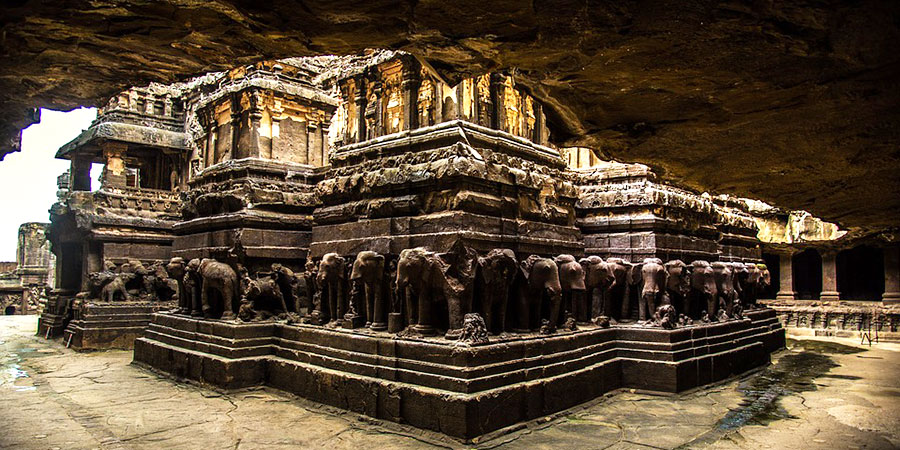Kailasa Temple, Aurangabad
Just 30 km (19mi) away from Aurangabad, the Ellora Caves are one of the prime examples of India’s rock-cut architecture. Constructed exclusively with only hammer and chisel, the artists slowly and steadily carved out beautiful temples, chapels, viharas out of steep slopes. Among these structures, the Kailasa Temple, Aurangabad is probably one of the greatest structures of them all. According to historical records, the temple represents the abode of Lord Shiva or Mt Kailasa. It was a massive project, and the workers had to remove close to 200,000 tonnes of rock by chisel and hammer, before shaping the temple.No trip to Ellora would be complete without exploring the interesting features of this fascinating temple. This write-up is meant to help visitors in exploring the cave more easily.
Keynote on Kailasa Temple, Aurangabad
![]() Address: Ellora Cave Rd, Ellora, Aurangabad, Maharashtra 431102
Address: Ellora Cave Rd, Ellora, Aurangabad, Maharashtra 431102
![]() Opening time: 7:00 am – 6:00 pm (Tuesday closed)
Opening time: 7:00 am – 6:00 pm (Tuesday closed)
![]() Entry Fee: 600 INR
Entry Fee: 600 INR
![]() Famous for: Detailed sculpting
Famous for: Detailed sculpting
![]() Visit Duration: Half a day
Visit Duration: Half a day
![]() Best time to visit: October to March is suitable for the trip
Best time to visit: October to March is suitable for the trip
![]() How to Reach: The Kailasa Temple is located inside the Ellora Caves complex. To reach Ellora, around 27 km (17mi) away from Aurangabad city, one can book private taxis or buses.
How to Reach: The Kailasa Temple is located inside the Ellora Caves complex. To reach Ellora, around 27 km (17mi) away from Aurangabad city, one can book private taxis or buses.

Kailasa Temple
|
Overview of the Kailasa Temple, Aurangabad
Probably one of the grandest rock-cut temples of India, the Kailash Temple was commissioned by King Krishna I in 760 AD. The monument represents the abode of Lord Shiva at Kailasha and contains intricately carved designs, sculptures, and details. Interestingly, the temple was carved out of one huge rock and took more than a decade to complete the structure.The monument covers the area twice as large as Parthenon in Athens and reality is an engineering marvel. The temple has quite a few carved panels, illustrating scenes from the different Hindu epics like Ramayana, and Mahabharata. The majestic monolithic pillars in the courtyard or the giant panels showcasing the ten incarnations of Lord Vishnu could also be seen here.
The Architecture of the Kailasa Temple in Aurangabad
Although there is no dedicatory inscription inside the temple premise, research shows that the temple was constructed by a Rashtrakuta ruler. The evidence reveals that the entire structure of the temple was meticulously planned before commencing the construction.One of the prime attractions of Ellora Caves, the showcases traces of Chalukya and Pallava architectural styles. Traces of Dravidian architecture enhance the beauty of the monument. A low gopuram, at the entrance to the temple courtyard, houses a huge Nandi bull – the ride of Shiva. Most of the sculptures on the left side of the temple are Shaivaite, while on the opposite wall deities belonging to Vaishnavaitism could be seen.
The arcades have majestic sculpted panels showcasing sculptures of different Hindu deities. The main Shiva temple is built on the second level of the complex and houses a smaller Nandi. Built-in vertical excavation method, starting from the top and gradually moving downwards, the temple is very fascinating.
Interesting Facts about the Aurangabad Kailasa Temple
 1. Largest monolithic structure in the world
1. Largest monolithic structure in the world
The monument holds the record of being the largest single monolithic excavation in the entire world. Multistoried temple structure, dedicated to Lord Shiva, was slowly carved out of the rock of the beautiful Charanandri hills. The entire sculptures, panels, and friezes were excavated from a single piece of rock.
 2. Made from vertical excavation method
2. Made from vertical excavation method
The temple is noteworthy for its vertical excavation, where workers carve the top of the monument first gradually moving downwards. According to records, rods and boulders were used to create this megastructure. Surprisingly, a single design and measurement were calculated meticulously, creating the flawless design of the monument.
 3. Showcases the mythical Mount Kailash
3. Showcases the mythical Mount Kailash
The temple is dedicated to Lord Shiva, an important deity in the Hindu pantheon, and represents the mythical abode of this god. Temple has two inner courtyards, the giant structure of the Nandi Bull, and consists of two floors. At the base level, the illusion of elephants holding the entire temple could be seen. Originally, the temple was covered with a plaster of limestone, giving the illusion of snow. Remnants of the plaster could be seen here.The Kailasa Temple in Aurangabad is a stunning complex, representing the best features of the Indian rock-cut architecture.

